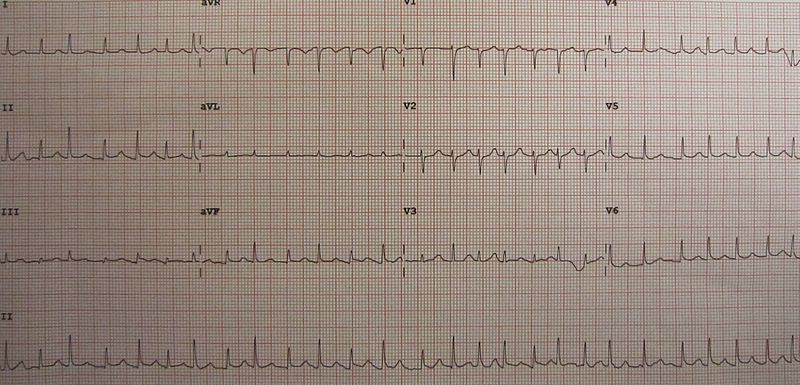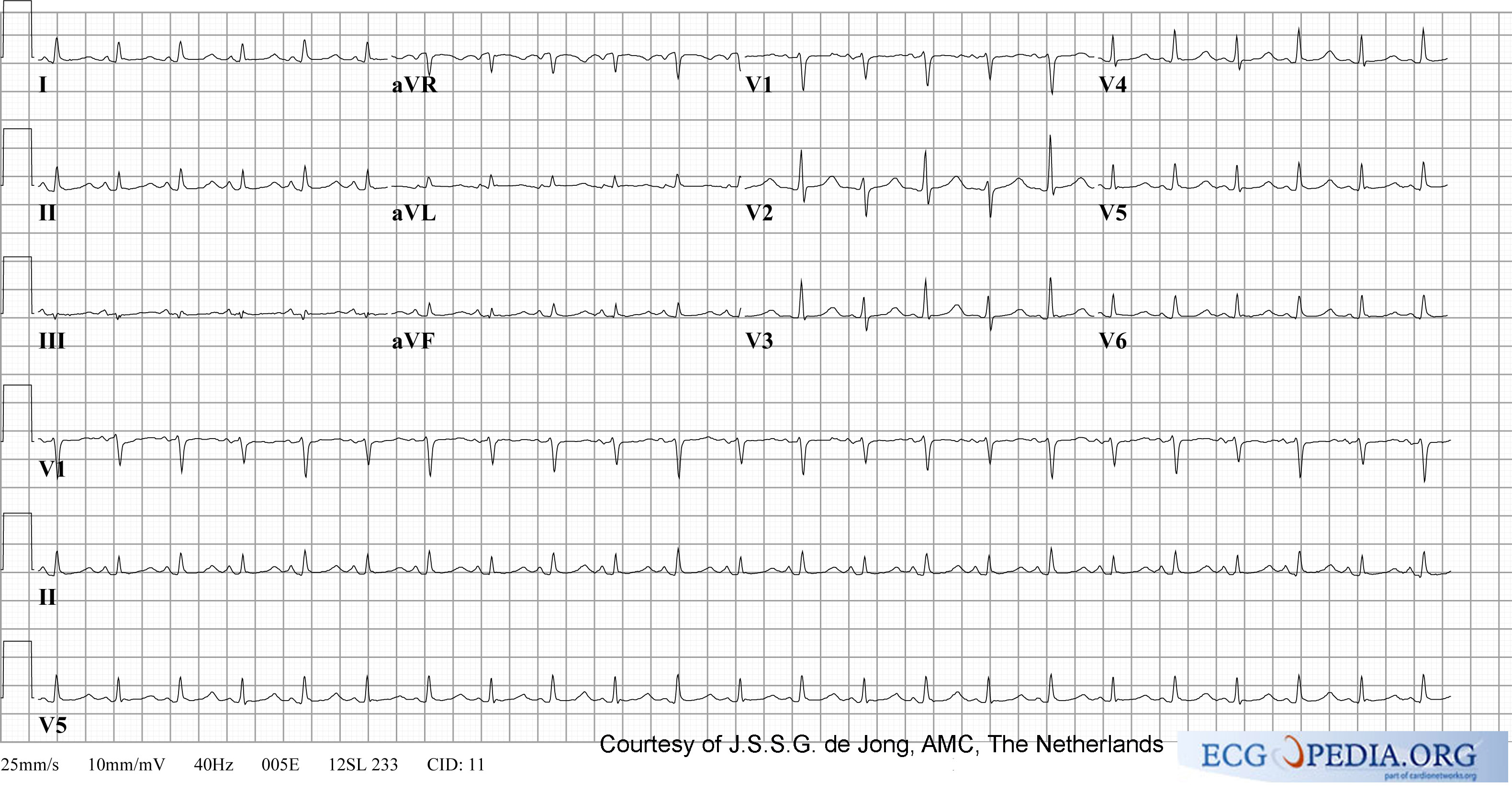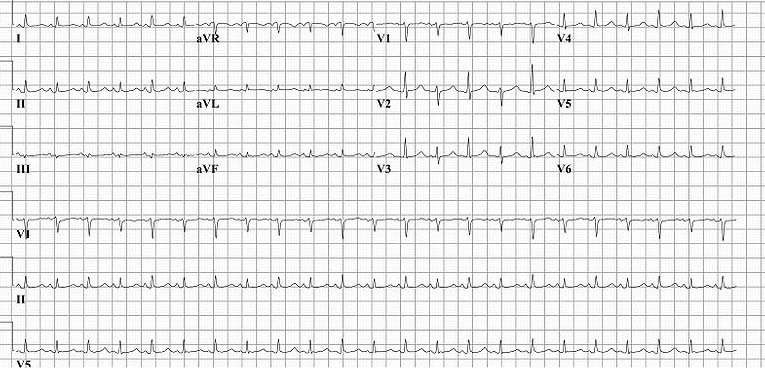Electrical alternans: Difference between revisions
| Line 136: | Line 136: | ||
==Electrocardiographic Examples== | ==Electrocardiographic Examples== | ||
[[Image:Alternans.jpg| | Shown below is an ECG showing electrical alternans in a person with pericardial effusion. Note the beat to beat change in the height and axis of the QRS complexes. | ||
[[Image:Alternans.jpg|center|500px|]] | |||
[[Image:Electrical Alternans.jpg| | ---- | ||
Shown below is an ECG showing electrical alternans in a person with pericardial effusion. Note the beat to beat change in the height and axis of the QRS complexes. | |||
[[Image:PulsusAlternans.jpg| | [[Image:Electrical Alternans.jpg|center|500px]] | ||
---- | |||
[[Image:Electrical alternans1.jpg | Shown below is an ECG showing electrical alternans in a person with pericardial effusion. Note the beat to beat change in the height and axis of the QRS complexes. | ||
[[Image:PulsusAlternans.jpg|center|500px]] | |||
---- | |||
Shown below is an ECG showing electrical alternans in a person with pericardial effusion. Note the beat to beat change in the orientation of the QRS, and axis of the QRS complexes.[[[[Image:Electrical alternans1.jpg|500px|center]] | |||
==References== | ==References== | ||
Revision as of 23:58, 23 September 2012
Editor-In-Chief: C. Michael Gibson, M.S., M.D. [1]
Overview
Electrical alternans is an electrocardiographic phenomenon which describes the beat to beat alternation in the height (ie.e amplitude), duration (the length of the interval) or the direction (up or down) of any of the EKG complexes or intervals. While electrical alernans is usually thought of as alternation in the height or direction of the QRS complex, there can also be P wave, PR interval, QRS complex, R-R interval, ST segment, T wave, or U wave forms of alternans (see classification below).
Historical Perspective
- 1909: First described by Hearing
- 1910: Elaborated upon by Sir Thomas Lewis
- 1948: First description of electrical alternans on the surfce EKG by Kalter and Schwartz [1]
Classification
There can be alternans of any of the EKG waveforms or intervals:
P wave alternans
PR interval alternans
QRS complex alternans
RR interval alternans
ST segment alternans
T wave alternans
U wave alternans
Pathophysiology
Electrical Alternans Due to Motion of the Heart
When the word alternans is used, the underlying pathophysiology that is most often thought of is alternans due to motion of the heart and its shifting position in relationship to the surface electrodes. The pathophysiologic mechanism underlying the alternation in the height or amplitude of the QRS complex is the swinging or shifting or the electrical axis of the heart. It should be noted that there can also be P wave and T wave alternans attributable to the motion of the heart.
While electrical alternans is frequently thought of in association with pericardial effusion, it should be noted that not all pericardial effusions cause electrical alternans, and that total electrical alternans (involving the p wave, QRS complex and the T wave) is present in just 5-10% of cases of cardiac tamponade.
It is underappreciated that the movement of the heart in hypertrophic cardiomyopathy can cause electrical altrical alternans as well.
Electrical Alternans Due to Changes in Electrical Conduction of the Heart
Electrical laternans can also be due to variation in the velocity of conduction through any of the anatomic structures of the heart. Usually this variation in the conductivity is caused by a change in heart rate, autonomic tone, vagal tone, or drugs. At a more fundamental level, the abnormality is thought to be due to changes in calcium handling in the sarcoplastic reticulum. The following complexes, either alone or in combination, may exhibit electrical alternans due to changes in electrical conduction: the P wave, the PR interval, the QRS complex, or the RR interval. The appearance of QRS alternans as part of a narrow complex tachycardia suggests the diagnosis of orthodromic atrioventricular (AV) reentrant tachycardia which conducts retrograde over an accessory pathway.
Electrical Alternans Due to Changes in Repolarization in the Heart
Repolarization alternans or electrical alternans due to changes in repolariation in the heart explains electrical alternans in the following EKG intervals or segments: ST segment alternans, T wave alternans, U wave alternans. The abnormality is thought to be due to changes in calcium handling in the sarcoplastic reticulum.
T wave Alternans
T wave alternans is observed in the setting of QT interval prolongation and rapid changes in heart rate.
Causes include alcoholic cardiomyopathy,amiodarone[2], following cardiac arrest,cardiopulmonary resuscitation, congestive heart failure, electrolyte imbalance, hypertrophic cardiomyopathy, hypocalcemia, hypokalemia, hypomagnesemia, long QT syndrome[3], pulmonary embolism, quinidine.
In so far as polymorphic VT or torsade de pointes are associated with a prolonged QT, T wave alternans is in effect an indirect marker of risk. T wave alternans has been used as a risk stratification tool for sudden death.[4]
ST Segment Alternans
ST segment alternans is defined as beat to beat variation in the magnitude or amplitude of ST segment elevation. It is most often due to myocardial ischemia and includes causes such as:
- Vasospastic angina pectoris
- Acute myocardial infarction
- Angina pectoris
- Myocardial ischemia during an exercise tolerance test
- Percutaneous transluminal coronary angioplasty (PTCA)
- Subarachnoid hemorrhage
Natural History, Complications and Prognosis
The presence of ST segment alternans in the setting of myocarial ischemia is associated with ventricualr tachycardia and ventricular fibrillation.
Causes
All Causes in Alphabetical Order
- Acute myocardial infarction
- Alcoholic cardiomyopathy
- Amiodarone[5]
- Angina pectoris
- Atrial fibrillation
- Atrioventricular reentrant tachycaria
- AV nodal reentry tachycardia
- AV reentry tachycardia
- Cardiac tamponade
- Cardiopulmonary resuscitation
- Congestive heart failure
- Electrolyte imbalance
- Following cardiac arrest
- Hypertrophic cardiomyopathy
- Hypertrophic cardiomyopathy
- Hypocalcemia
- Hypokalemia
- Hypomagnesemia
- Left ventricular dysfunction
- Long QT syndrome[6]
- Myocardial contusion
- Myocardial ischemia
- Myocardial ischemia during an exercise tolerance test
- Percutaneous transluminal coronary angioplasty (PTCA)
- Pericardial effusion
- Polymorphic ventricular tachycardia
- Pulmonary embolism
- Pulmonary embolism
- Quinidine
- Rheumatic heart disease
- Subarachnoid hemorrhage
- Torsade de pointes
- Vasospastic angina pectoris
- Wolff-Parkinson-White syndrome
Due to Motion of the Heart
Due to Changes in Impulse Conduction
- Atrial fibrillation
- Atrioventricular reentrant tachycaria
- Left ventricular dysfunction
- Myocardial contusion
- Myocardial ischemia
- Pulmonary embolism
- Rheumatic heart disease
- Wolff-Parkinson-White syndrome
Due to Changes in Repolarization
T wave Alternans
- Alcoholic cardiomyopathy
- Amiodarone[7]
- Following cardiac arrest
- Cardiopulmonary resuscitation
- Congestive heart failure
- Electrolyte imbalance
- Hypertrophic cardiomyopathy
- Hypocalcemia
- Hypokalemia
- Hypomagnesemia
- Long QT syndrome[8]
- Pulmonary embolism
- Quinidine
ST segment alternans
- Vasospastic angina pectoris
- Acute myocardial infarction
- Angina pectoris
- Myocardial ischemia during an exercise tolerance test
- Percutaneous transluminal coronary angioplasty (PTCA)
- Subarachnoid hemorrhage
Differentiating Electrical Alternans form other Disorders
The electrical form of alternans should be differentiated from the mechanical form alternans in which case there is alternation of the strength of the pulse as is observed in pulsus alternans. Electrical and mechanical alternans may coexist.
Electrocardiographic Examples
Shown below is an ECG showing electrical alternans in a person with pericardial effusion. Note the beat to beat change in the height and axis of the QRS complexes.

Shown below is an ECG showing electrical alternans in a person with pericardial effusion. Note the beat to beat change in the height and axis of the QRS complexes.

Shown below is an ECG showing electrical alternans in a person with pericardial effusion. Note the beat to beat change in the height and axis of the QRS complexes.

Shown below is an ECG showing electrical alternans in a person with pericardial effusion. Note the beat to beat change in the orientation of the QRS, and axis of the QRS complexes.[[

References
- ↑ Kalter HH, Schwartz ML. Electrical alternans. NY State J Med. 1948;1:1164-66.
- ↑ Bardaji A, Vidal F, Richart C. T wave alternans associated with amiodarone. J Electrocardiol. Apr 1993;26(2):155-7.
- ↑ Cruz Filho FE, Maia IG, Fagundes ML, et al. Electrical behavior of T-wave polarity alternans in patients with congenital long QT syndrome. J Am Coll Cardiol. Jul 2000;36(1):167-73.
- ↑ Pastore JM, Girouard SD, Laurita KR, Akar FG, Rosenbaum DS. Mechanism linking T-wave alternans to the genesis of cardiac fibrillation. Circulation. Mar 16 1999;99(10):1385-94.
- ↑ Bardaji A, Vidal F, Richart C. T wave alternans associated with amiodarone. J Electrocardiol. Apr 1993;26(2):155-7.
- ↑ Cruz Filho FE, Maia IG, Fagundes ML, et al. Electrical behavior of T-wave polarity alternans in patients with congenital long QT syndrome. J Am Coll Cardiol. Jul 2000;36(1):167-73.
- ↑ Bardaji A, Vidal F, Richart C. T wave alternans associated with amiodarone. J Electrocardiol. Apr 1993;26(2):155-7.
- ↑ Cruz Filho FE, Maia IG, Fagundes ML, et al. Electrical behavior of T-wave polarity alternans in patients with congenital long QT syndrome. J Am Coll Cardiol. Jul 2000;36(1):167-73.